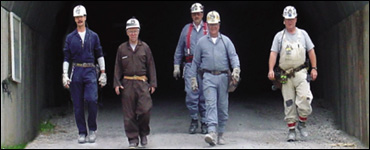CDC Features
Designing Safe Mining Operations

The National Institute for Occupational Safety and Health (NIOSH) provides extensive resources that can help mine operators and mine workers to anticipate risks of roof falls in mines, to anticipate potential hazards in retreat mining operations, and to design safe mining operations that reduce such risks. NIOSH also provides resources to help keep emergency responders safe if an incident occurs and rescue or recovery efforts are undertaken. According to news reports, rescue activities began on August 6 at a coal mine in Huntington, Utah, where six miners were trapped after a roof collapse. The exact cause of the collapse was not immediately known, reports indicated.
NIOSH is the federal agency that conducts research and makes recommendations to prevent work-related injuries, illnesses, and deaths. Collaborating with diverse partners, NIOSH mining safety laboratories in Pittsburgh, Pennsylvania, and Spokane, Washington, lead the national research in the U.S. in mine safety and health. This research has resulted in fundamental advancements in understanding complex factors that can put mine workers at risk, designing effective protective measures, and developing and applying innovative safety technologies.
NIOSH Resources
• A NIOSH report discusses technologies for safe retreat mining. In retreat mining, pillars of stone and coal that support a mine roof are removed for the coal after operations end in the mine area. Removing the pillars poses a risk for roof instability.
• NIOSH engineers describe design methods and technologies for reducing the risk of ground falls during pillar recovery.
• A pioneering NIOSH analysis describes considerations for safe pillar removal in retreat mining.
• Characteristics of coal mine "bumps"—sudden failures or movements of rock strata above and around coal mines that generate explosive forces—are described in a NIOSH research paper based on five case studies.
• NIOSH developed and provides a PC-based system to monitor stresses that can make rock unstable.
• A NIOSH case study analyzes the characteristics of a large-scale rock burst and recommends control measures for preventing such incidents.
• The characteristics of faint earth tremors associated with mining can help scientists assess instabilities that can lead to large-scale rock falls, a NIOSH study found.
• NIOSH also provides resources to help mine operators plan for emergency response, including support in conducting rescue training simulations, and improving technologies used in mine rescue.
Further information about NIOSH's research and recommendations for preventing job-related injury, illness, and death in mining is available at http://www.cdc.gov/niosh/mining/.
Page last updated: August 7, 2007
Content source: National Institute for Occupational Safety and Health
Content owner: National Center for Health Marketing
URL for this page: www.cdc.gov/Features/MineSafety


